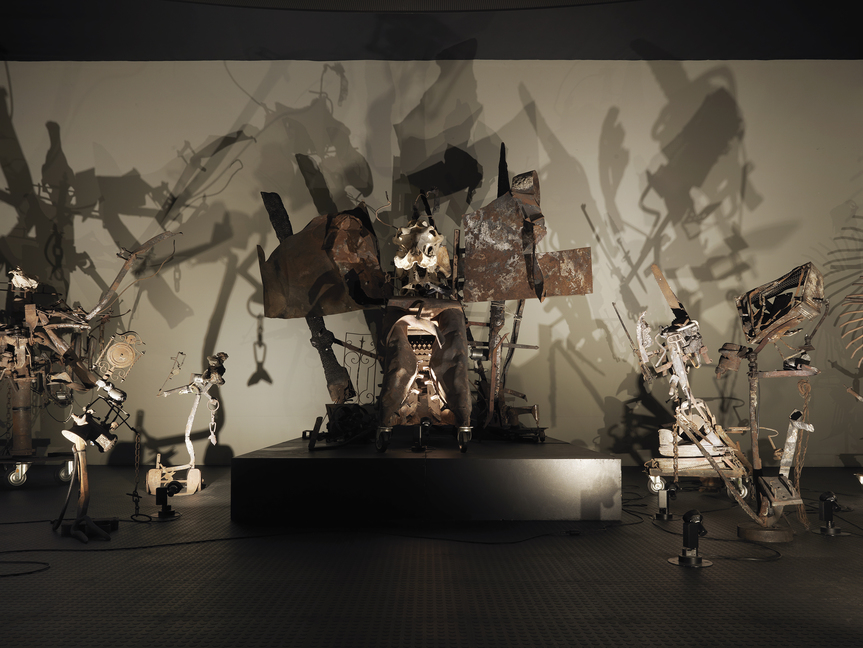-
From Current Issue
-
- Editor’s Letter Fire in the Heart
- Reviews I Gusti Ayu Kadek Murniasih
- Reviews 11th Seoul Mediacity Biennale: “One Escape at a Time”
- Dispatch Networked China
- One on One Monira Al Qadiri on Yukio Mishima
- Essays The rise of independent art spaces in pandemic-era Shanghai
- Features Tuan Andrew Nguyen
- Table of Contents
- Web Exclusives
- Archive
- Subscribe

R
E
V N
E
X
T
Installation view of GAURI GILL’s “Traces” at Museum Tinguely, Basel, 2018. Courtesy the artist and Museum Tinguely.
Indian photographer Gauri Gill was invited by Basel’s Museum Tinguely to exhibit her work alongside late Swiss artist Jean Tinguely’s (1925–91) iconic installation, Mengele-Totentanz (1986), inspired by a fire that had occurred near the artist’s Neyruz studio. In response to Tinguely’s work, Gill selected two monochromatic photographic series, “Traces” and “Birth Series,” from her extensive ongoing body of work, “Notes from the Desert” (1999– ), which documents her interactions with members of rural desert communities in western Rajasthan. With observational detachment, Gill presents large-format images of gravesites (“Traces”) alongside smaller photographs capturing the birth of the local midwife’s granddaughter (“Birth Series”), illustrating the mutual importance of life and death as part of the natural cycle.
On the same floor as the exhibition, Mengele-Totentanz comprises 14 kinetic sculptures made from mobile machine parts, charred metal, wood, fabric, and skulls of animals including a hippopotamus and cow, presented in a darkened, chapel-shaped room, with the objects in the installation throwing stark shadows on the walls. Shadow play is similarly a central feature in Gill’s large-format monochromatic series “Traces.”The discreet graves depicted in the photographs have been marked by friends and family with available materials, such as hand-inscribed stones and shards of pottery, simple gestures that pay homage and cultivate memory in the barren environment. Photographed under the harsh desert sun, the grave markers and their shadows add depth to the otherwise flat, sandy landscape. Yet, while “Traces” and Mengele-Totentanz share thematic similarities in their engagement with the act of memorializing the dead, the works differ in their pageantry. Tinguely’s work is overwhelming in its theatricality, which is especially apparent in the overtly sinister imagery and dramatic use of light and shadow. Contrastively, conscious of her role as an outsider, Gill shows a documentarian restraint with “Traces”; the photographs depict the silent spaces as they are, without any sign of the artist’s hand or subjective interpretation.
Notably, Gill’s photographic series reveals graves that are devoid of religious markings, though they belong to members of both Hindu and Muslim communities in Rajasthan. For instance, one untitled photograph depicts mounds of earth, draped with a cloth held in place by three earthen pots and two rocks. The care taken by Gill to present the heterogeneous desert communities without references to their specific cultural identities is remarkable given the charged sectarian nature of contemporary Indian society and politics. This provides a marked contrast to Tinguely’s installation, which is laden with references to Christianity.
The second part of Gill’s exhibition presents “Birth Series,”a set of eight smaller works portraying the artist’s friend Kasumbi Dai, a traditional midwife in the community, assisting in the birth of her granddaughter. Gill was personally invited to record the occasion, which took place in Dai’s home. Solemn, matter-of-fact depictions of village women preparing for the birth in a wooden, thatch-roofed hut with a sandy floor seem a world away from Tinguely’s installation until one notices that the apex of Mengele-Totentanz, which Tinguely called the “high altar,” is directly opposite a photograph of the mother drawing out her skirt over her bent legs as she bears down to give birth. The triangular form made by the spread skirt is uncannily similar to the shape of Tinguely’s macabre centerpiece, composed of a hippopotamus skull and a corn press manufactured by the German Mengele company—established by the family of notorious Nazi doctor Josef Mengele, who conducted deadly human experiments on prisoners at Auschwitz. This dialogue between Mengele-Totentanz and Gill’s “Birth Series” thus presents an answer to death with life.
The two exhibitions seem at first glance not to have much in common. Gill’s photographs of the quotidian life of a rural community encourage a matter-of-factness about the cornerstones of life—birth and death—whereas Tinguely’s witnessing of a fire launched him into a highly theatrical work that moves beyond mortuary themes to engage with the more traumatic aspects of European history. A closer look, however, revealed how the exhibitions in tandem set up an interesting conversation about the ways in which artists memorialize existential encounters within their socio-political contexts.
Gauri Gill’s “Traces” is on view at Museum Tinguely, Basel, until November 1, 2018.
To read more of ArtAsiaPacific’s articles, visit our Digital Library.






